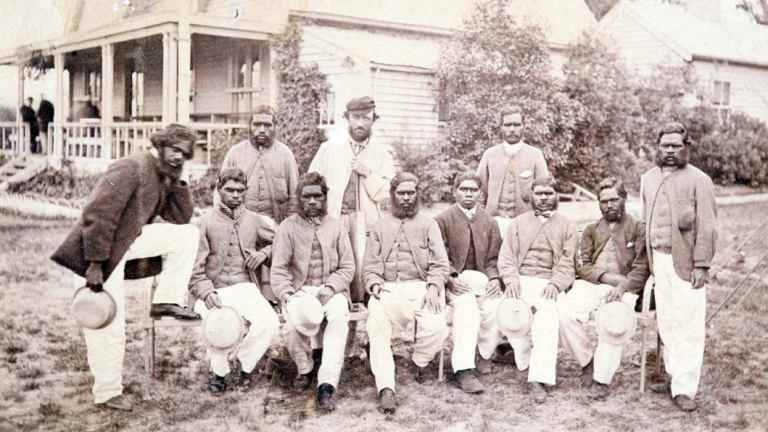Tom Wills enters your life like a ghost and haunts you. His power comes from the fact that he straddles the most fundamental fault line in the Australian psyche.
The contemporary idea of heroes basically comes from Hollywood. We think of heroes as good guys. Indeed, it is often not enough for them to be good guys, we want them to be perfect. The older idea, shared by the ancient Greeks and Aboriginal and Irish dreamtimes, was that heroes can be as complex as human nature. Ultimately, what distinguishes them, and determines their ability to travel through time, is the power of their stories.
In his time (1835-1880), his critics saw him as selfish, temperamental and immature, a bad sport, a gambler and a drunkard. But, as much as his detractors then and now may wish it otherwise, Tom Wills’ story has undeniable power.
He grew up at Moyston, outside Ararat, playing with the local Aboriginal children, the Tjapwurrung. He knew Tjapwurrung songs and dances, played their games, could speak their language and took a cache of Tjapwurrung weapons when he was shipped off to the Rugby school in England at the age of 15.
In 1861, his father was killed by Aborigines in Queensland in the biggest massacre of whites by blacks in Australian history (perhaps 10 times as many blacks died in the retributive raids that followed). Five years later at the MCG, Tom Wills stood as captain of the Australian Native XI along with his Aboriginal teammates for one of the most dramatic team photos in Australian sporting history.
Tom Wills with the 1866 Aboriginal cricket team.Credit:National Museum of Australia
Making sense of Tom Wills’ life is a daunting task, one that was probably beyond Tom himself. He committed suicide at 44 and was buried in an unmarked grave. Along the way he had revolutionised Victorian cricket and, in so far as any individual can be said to have "invented" Australian rules football, he’s that individual.
My first attempt to write about Tom Wills, titled The Call, was billed as a novel. It was a novel with a difference because there was a lot about the central character left unexplained. I proceeded on the basis that Tom was a whitefella whose life had been influenced by Aboriginal culture but the critical question was – how deeply had his life been influenced by Aboriginal culture?
In 2006, when director Bruce Myles staged an adaption of The Call at the Playhouse Theatre, the first question asked by the Aboriginal dancer (now deceased) at the initial reading of the script was, “Did Tom go through Law?” That is, was he initiated? The question was referred to me. Of course, I didn’t know the answer. What I do know from reading his father’s dairies is that after Tom went to Rugby the Tjapwurrung elders sent a young man to the Wills mansion to ask when Tom was coming home again – they clearly had some trust or confidence in him. Or a need of him as a messenger between the cultures.
As a novelist, you are expected to provide answers to questions like – why did Tom Wills coach the Aboriginal cricket team five years after his father was killed by Aborigines? Again, I couldn’t say. I just knew a few facts which may or may not be relevant. Rugby school, when he was there, taught a creed called muscular Christianity. He was in a religious delirium when he died. Did he have a religious motive?
Or was he a professional sportsman in need of a gig and this was a contract he could fulfil? He’d played with Aboriginal people before. And maybe he had the Aboriginal view that blaming a Victorian Aboriginal man for a murder committed in Queensland is like blaming a Sicilian for a murder committed at the other end of Europe. So that’s how I wrote the book – I drew the parts of the picture I could see and left the reader to make up their own minds from the other information I supplied.
Part of what makes Tom Wills so fascinating is that you never get to the end of his story. I’m not sure we can ever know him – I’ve met whitefellas who can speak an Aboriginal language but I’ve never met one who grew up, as he did, knowing the Aboriginal language and Aboriginal creation stories for the place he was from, knowing them as a natural part of his boyhood. The only character in any way similar would be controversial anthropologist Ted Strehlow, another fascinating and uniquely Australian story.
About five years ago, I joined a group determined to get Tom Wills onto the silver screen in the belief that only film or television could elevate this character to the degree of national recognition he deserved. I wrote the treatment. This was the first time in writing about Tom Wills that I handed the ingredients of the story over to my imagination.
We didn’t get the film "up", as they say in the industry – the responses were uniformly depressing. Commercial networks thought the story was too dark given the violent nature of his end. But his suicide wasn’t to be the end of the film. That was Warlpiri man Liam Jurrah taking the 2010 AFL mark of the year, a celebration of this uniquely Australian game in which Aboriginal and non-Aboriginal people have found some sort of balance.
As a small act of cultural defiance, a member of our group, Tom Thomson, has taken it upon himself to publish my treatment as a small book titled The Tom Wills Picture Show. The treatment has 58 scenes, each of which is written as a picture, and is illustrated with contemporary photographs. A light read, it will take you about as long to read as it would have taken to watch the film.
The Tom Wills Picture Show (ETT Imprint) recommended retail price $24.95
Source: Read Full Article
